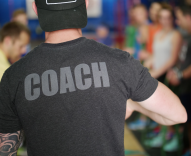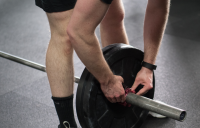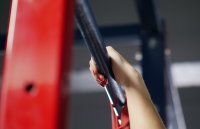This is a guest post from an athlete at The Hill – Christi Crumpecker
I keep this quote inside my front door. It’s my pep talk to myself before I leave for the day.
Hanging in my bathroom: “In this house, we do difficult things”
On the back of my closet door, I’ve pasted some favorite movie lines that, while profanity-filled, reveal that courage is the reward for doing the thing you were scared to do.
I’m afraid of a lot of things, everyday. Big things, little things. Ones that scare you, too, and ones you’ve never thought of. As many of you know, I struggle with chronic depression and anxiety that sometimes leave me paralyzed with grief and worry. They have kept me out of the gym for months at a time, made medical training a struggle, and strained many of my relationships. Last fall and winter were difficult; I gave in to overwork and stopped maintaining my healthy practices, such as they were. I tried several things to “get back in the saddle” and finally, by April, settled back into a routine of personal training and occasional group classes at CrossFit Memorial Hill. This week marks 6 months of consistent exercise for me, I recently added nutrition to my “work” and I’m feeling better than ever. No, every day is not full of sunshine and rainbows. I’m not “cured” of what ails me. This is not about “before” and “after” photos, and I have some new PRs but they are not relevant here. I’m feeling stable and my confidence continues to grow, and that’s what matters to me.
I’ve been thinking hard about the coming darker months and am working on how to make my routine “bulletproof” so it can carry me through the (likely) difficult days ahead. While I don’t have any groundbreaking advice to offer, for any of you who are struggling, here are the things that are working for me right now:
Get a professional opinion
If you are experiencing symptoms of depression or anxiety, see a doctor. If you don’t feel comfortable talking to your doctor about these things, get a new one. Primary care providers are trained to address many mental health concerns, as well as investigate for other medical causes of depressive and anxious symptoms. Get counseling if you can; seek a support group; try medication if it’s recommended. Complex diseases may require a multi-faceted approach to improve. And of course–exercise, even if it’s just a walk around the block. Do any little thing you can improve your nutrition. Drink water. Get enough sleep. Pet dogs. Allow yourself every opportunity to recover, in every way.
Find your tribe
It may be in-house emotional support, an “activity buddy,” an accountability resource, a professional counselor…in my case, it was CrossFit coaches and other gym members who helped me the most. They have cheered me on and reassured me during some of the most challenging moments. Coach Josh is waiting for me at a specific time, three days a week, and I take that commitment seriously. Another member meets me at the gym to partner with me Saturday mornings. Sometimes, the social contract we’ve created will motivate me to keep going when nothing else would. And my sense of belonging at The Hill has given me a soft place to land when the rest of world is full of sharp edges.
Don’t worry about being motivated
Big win for me! Finally embracing the idea that I really didn’t have to WANT to go to the gym, or do anything for that matter. I could be as scared and lazy as I wanted. I just had to put on my workout clothes and walk in the door. Feelings and thoughts and behaviors are all related, and you can change one and positively influence the others. For me, the behavior was the easiest thing to go after. Putting one foot in front of the other, whether to walk in the door of the gym or complete that last sled push, helps me make progress even when my thoughts and feelings aren’t quite where I want them.
Let go of your resistance
I quit focusing on major goals, and “needing” motivations, and even “making progress” and started looking at what was causing me to WANT to stay where I was–overweight, sad, fatigued, etc. Turns out, I had lots of reasons, good reasons, protective reasons, not to change. Those reasons are different for everybody, but we all have them. Get to know them. Embrace them. Then let them go. One at a time is okay, and know that they will come back to pay a visit once in a while. That’s alright, too. Acknowledge them and recognize they have served you well, but they do not need to predict your future. I’ve never been able to wrap my mind around that meditation-type “let your thoughts and feelings float past” thing. Mine have always felt heavy and visceral. Finally, someone told me, “You can just sit that crap down for a while. It will still be there if you want to pick it up later.” Yes, I can. I will.
Set super-achievable goals
For MONTHS, my only gym goal was to “show up and try.” That was it. For the first time, I set myself up for success by keeping my goal deliberately tiny. After a few weeks of victory, I was itching to set a “real” goal, like a 200lb deadlift! But I held myself back, told myself it wasn’t time yet. Finally, just recently, I started setting slightly higher performance goals for myself. I stopped telling myself “You can quit anytime you need to” during workouts. Just the act of removing that line from my “mental vocabulary” made a huge difference in how I approached the workouts and managed to fight through them. Set little goals. Achieve them. Celebrate! Repeat.
Stay present
This has been the hardest battle for me, though it’s amazing how “present” not being able to breathe can make you! But even in the middle of a workout, it’s hard not to think ahead with anxious anticipation to the remaining reps or rounds. Keeping focused on the moment, whether it’s the more general “check your ego at the door” mentality or staying focused on the current kettlebell swing, has saved me a lot of worry about things that may (or may not) happen in the future. I try to notice when I’m fretting about the past (things I can’t change) or the future (things I can’t predict) and compassionately redirect my attention to the present with something tangible. Lately I’ve been fond of consciously pushing my weight through my heels, which feels physically and mentally grounding.
Allow for pain…and joy
Sometimes just letting yourself suffer, I mean REALLY getting into it, is paradoxically relaxing. Once I have “given up” the strain of resisting my feelings, pain is usually not as bad as I thought it would be. This goes for depression as well as burpees. And oddly, once I did not spend as much energy resisting pain, I discovered a feeling I have rarely experienced: pure joy! To paraphrase one of my favorite physician/writers, “joy” is not so much happiness as it is to committing fully to life and whatever it may bring. CrossFitters may say, “Uh, isn’t that just the endorphins talking?” Whatever it is, I’ll take it.
Let your routine carry you
For a while, a new routine is a bit of work. You have to figure out what is reasonable and you have to actually DO it for a while before you get to call it a routine. But once it’s rolling, just let it take you along for the ride. If the routine is sound, the work will carry you to places you can’t even imagine right now. You just tear right on past those super-achievable goals and keep right on going (don’t forget to celebrate!). That’s my plan for the coming months, which will likely present some challenges for me. I stay in close contact with my coaches to make sure that I’m on the right track and we can make minor adjustments if needed, but overall the plan has been working, and I’ll stick with it.
I don’t have all the answers. Ask me in a year, and things may have changed considerably. For now, these eight pointers have allowed me to make incredible progress in fitness, physical and mental. Feeling so much better is its own reward. Continuing to view myself and my ongoing adventures with curiosity and compassion will allow me to grow and change as needed. For now, I’ll feel the fear and do it anyway, though every day at The Hill I have less fear as it is replaced with competence and confidence. I would like to extend my deep gratitude to Coach Josh Snyder and Coach Matt Scanlon, as well as all the other coaches and members, for continuously fostering the CrossFit Memorial Hill mission and recognizing the potential even in their most challenging athletes. I’m proud of you, and more and more I’m proud of me, too!













